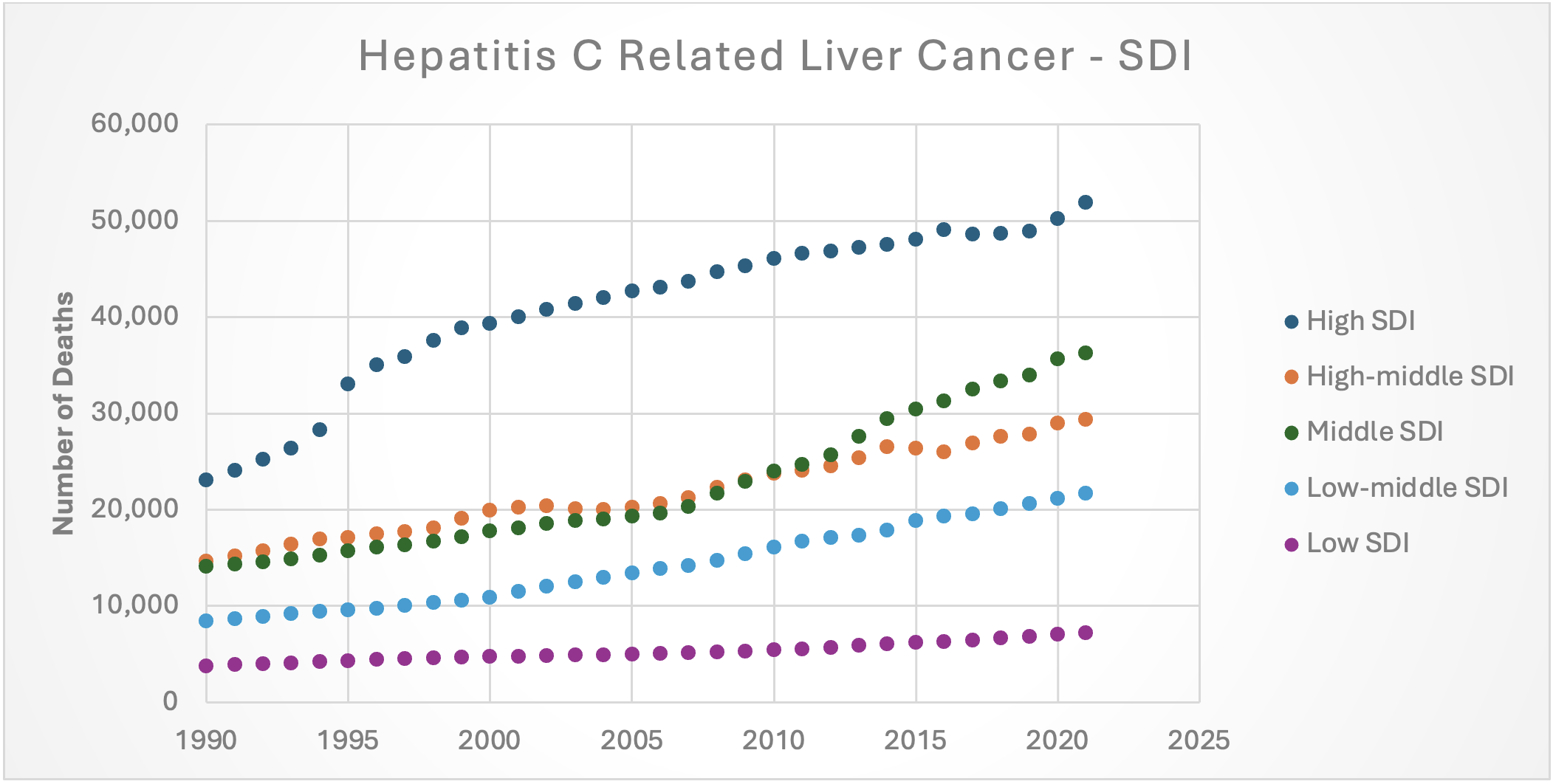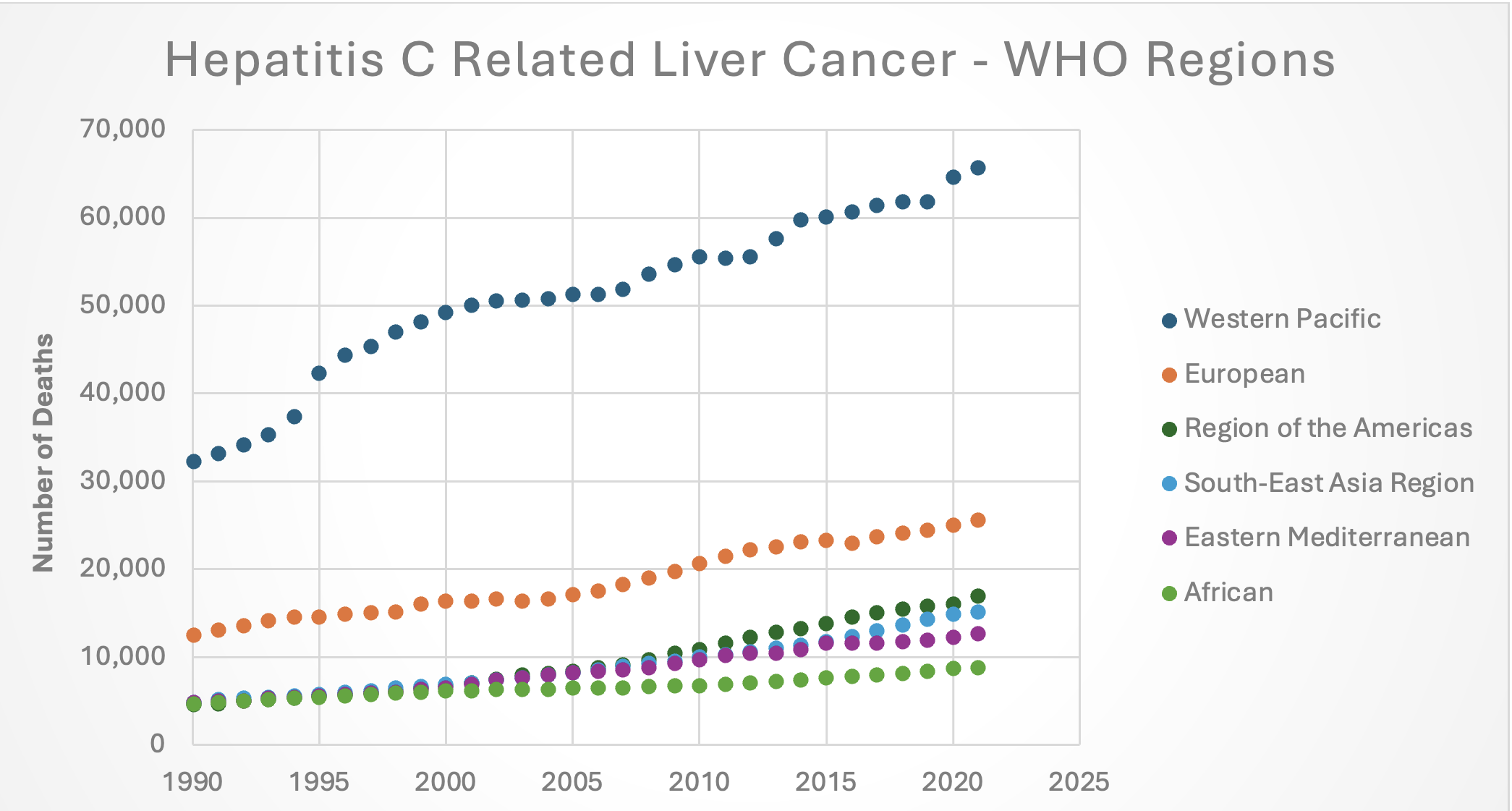Tuesday Poster Session
Category: Liver
P5907 - Revealing New Trends in the Global Burden of Liver Cancer Related to Hepatitis C Virus
Tuesday, October 28, 2025
10:30 AM - 4:00 PM PDT
Location: Exhibit Hall

Lynette Sequeira, MD
Johns Hopkins University School of Medicine
Baltimore, MD
Presenting Author(s)
Lynette Sequeira, MD1, Xiaohan Ying, MD2, Arun Jesudian, MD, FACG3
1Johns Hopkins University School of Medicine, Baltimore, MD; 2NewYork-Presbyterian / Weill Cornell Medical Center, New York, NY; 3NewYork-Presbyterian Hospital/Weill Cornell Medical Center, New York, NY
Introduction: Hepatocellular carcinoma (HCC) remains a leading cause of global cancer mortality, with a continually increasing incidence and poor 5-year survival. Hepatitis C virus (HCV) is a major risk factor for HCC, and while direct-acting antivirals (DAAs) have significantly reduced HCV-related HCC (HCV-HCC) risk, its global burden remains high. Given recent World Helath Organization (WHO) initiatives to aimed at reducing hepatitis-related mortality, we evaluated trends in HCV-HCC from 1990 to 2021, stratified by gender, WHO region, and sociodemographic index (SDI), using data from the Global Burden of Disease 2021 study.
Methods: We extracted data on deaths, disability-adjusted life years (DALYs), and age-standardized incidence (ASI) attributable to HCV. Trends were analyzed using Joinpoint regression to calculate annual percent change (APC) and average annual percent change (AAPC), with significance set at p< 0.05.
Results: Globally, HCV-HCC deaths increased from 1990 to 2021 (female AAPC 2.71 with 95% CI: 2.67–2.75 and male AAPC 2.65 with 95% CI: 2.60–2.70). Global DALYs also increased (female AAPC 2.28 with 95% CI: 2.24–2.32 and male AAPC 2.16 with 95% CI: 2.10–2.21). In contrast, ASI declined (female AAPC -0.51 with 95% CI: -0.53 to -0.51 and male AAPC -0.57 with 95% CI -0.61 to -0.53).
In terms of WHO regions, DALYs rose across all WHO regions, with the Americas and Southeast Asia showing the highest increases. Deaths followed similar patterns, especially among males in the Americas and Eastern Mediterranean (Figure 1). ASI rates decreased in Africa, Western Pacific, and Eastern Mediterranean but rose in the Americas, Europe, and Southeast Asia.
By SDI, middle and middle-low regions had the steepest increases in DALYs and deaths (Figure 2). High SDI regions saw the sharpest ASI declines after 2016, coinciding with WHO strategy implementation. ASI rates for females rose in high SDI settings and declined less than in males. Notably, ASI began to rise again after 2019 for both sexes.
Discussion: Despite treatment advances, absolute HCV-HCC burden has grown unevenly. The increase in HCV-HCC deaths and DALYs with overall decreased ASI could indicate a rising disease burden due to population aging and growth. Regions with better resources saw ASI reductions, while others lagged. Gender and SDI disparities highlight gaps in access to care, screening, and treatment. Tailored interventions, improved equity, and sustained global efforts are essential to achieve hepatitis elimination goals.

Figure: Figure 1. Hepatitis C-Related Liver Cancer deaths stratified by WHO Region

Figure: Figure 2. Hepatitis C-Related Liver Cancer deaths stratified by sociodemographic index
Disclosures:
Lynette Sequeira indicated no relevant financial relationships.
Xiaohan Ying indicated no relevant financial relationships.
Arun Jesudian: Madrigal Pharmaceuticals – Speakers Bureau. Mallinckrodt Pharmaceuticals – Consultant, Speakers Bureau. Salix Pharmaceuticals – Consultant, Speakers Bureau.
Lynette Sequeira, MD1, Xiaohan Ying, MD2, Arun Jesudian, MD, FACG3. P5907 - Revealing New Trends in the Global Burden of Liver Cancer Related to Hepatitis C Virus, ACG 2025 Annual Scientific Meeting Abstracts. Phoenix, AZ: American College of Gastroenterology.
1Johns Hopkins University School of Medicine, Baltimore, MD; 2NewYork-Presbyterian / Weill Cornell Medical Center, New York, NY; 3NewYork-Presbyterian Hospital/Weill Cornell Medical Center, New York, NY
Introduction: Hepatocellular carcinoma (HCC) remains a leading cause of global cancer mortality, with a continually increasing incidence and poor 5-year survival. Hepatitis C virus (HCV) is a major risk factor for HCC, and while direct-acting antivirals (DAAs) have significantly reduced HCV-related HCC (HCV-HCC) risk, its global burden remains high. Given recent World Helath Organization (WHO) initiatives to aimed at reducing hepatitis-related mortality, we evaluated trends in HCV-HCC from 1990 to 2021, stratified by gender, WHO region, and sociodemographic index (SDI), using data from the Global Burden of Disease 2021 study.
Methods: We extracted data on deaths, disability-adjusted life years (DALYs), and age-standardized incidence (ASI) attributable to HCV. Trends were analyzed using Joinpoint regression to calculate annual percent change (APC) and average annual percent change (AAPC), with significance set at p< 0.05.
Results: Globally, HCV-HCC deaths increased from 1990 to 2021 (female AAPC 2.71 with 95% CI: 2.67–2.75 and male AAPC 2.65 with 95% CI: 2.60–2.70). Global DALYs also increased (female AAPC 2.28 with 95% CI: 2.24–2.32 and male AAPC 2.16 with 95% CI: 2.10–2.21). In contrast, ASI declined (female AAPC -0.51 with 95% CI: -0.53 to -0.51 and male AAPC -0.57 with 95% CI -0.61 to -0.53).
In terms of WHO regions, DALYs rose across all WHO regions, with the Americas and Southeast Asia showing the highest increases. Deaths followed similar patterns, especially among males in the Americas and Eastern Mediterranean (Figure 1). ASI rates decreased in Africa, Western Pacific, and Eastern Mediterranean but rose in the Americas, Europe, and Southeast Asia.
By SDI, middle and middle-low regions had the steepest increases in DALYs and deaths (Figure 2). High SDI regions saw the sharpest ASI declines after 2016, coinciding with WHO strategy implementation. ASI rates for females rose in high SDI settings and declined less than in males. Notably, ASI began to rise again after 2019 for both sexes.
Discussion: Despite treatment advances, absolute HCV-HCC burden has grown unevenly. The increase in HCV-HCC deaths and DALYs with overall decreased ASI could indicate a rising disease burden due to population aging and growth. Regions with better resources saw ASI reductions, while others lagged. Gender and SDI disparities highlight gaps in access to care, screening, and treatment. Tailored interventions, improved equity, and sustained global efforts are essential to achieve hepatitis elimination goals.

Figure: Figure 1. Hepatitis C-Related Liver Cancer deaths stratified by WHO Region

Figure: Figure 2. Hepatitis C-Related Liver Cancer deaths stratified by sociodemographic index
Disclosures:
Lynette Sequeira indicated no relevant financial relationships.
Xiaohan Ying indicated no relevant financial relationships.
Arun Jesudian: Madrigal Pharmaceuticals – Speakers Bureau. Mallinckrodt Pharmaceuticals – Consultant, Speakers Bureau. Salix Pharmaceuticals – Consultant, Speakers Bureau.
Lynette Sequeira, MD1, Xiaohan Ying, MD2, Arun Jesudian, MD, FACG3. P5907 - Revealing New Trends in the Global Burden of Liver Cancer Related to Hepatitis C Virus, ACG 2025 Annual Scientific Meeting Abstracts. Phoenix, AZ: American College of Gastroenterology.
